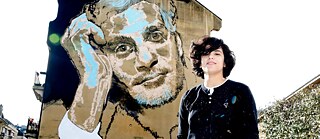The multidisciplinary artist Aya Tarek based in Alexandria started her artwork in graphic design in her own studio 16 years ago. Now she is a global artist that reinvents public spaces while keeping up with social and global issues of our time. Jenin Elena Abbas spoke with Aya about the business and management side of arts and on how she defines herself as an artist.
I am a multidisciplinary artist based in Alexandria. My profession started while I was still an undergraduate student at the Fine Arts school in Alexandria. Initially, I worked a lot with graphic design as I slowly built my own studio. Although I plan a lot in my studio, my practice mainly takes place in many different cities around the world. I am famous for large-scale murals and public commissions, which I started doing more of after my graffiti was recognized through the early years of Facebook, circa 2008.
What sets you apart as an artist?
I give a lot of my attention to marketing, networking and being closely in touch with society, the world and local & global movements and developments. For me, art and my practice are interconnected with everything else around me, including other professional fields and events. They are equally important to art and vice versa. I am also interested in the business aspect of my field, all while preserving the integrity and cultural significance of my work.
I often wondered why aside from artists, this question would be deemed inappropriate to ask of other professionals, yet I would still like to answer. I have been working in this industry for 15 years and I am able to live off my profession. However, I find it crucial for artists to invest their money, which I have been doing for as long as I remember. There are several ways to invest, whether it be in the stock market or other more tangible assets.
Did artistic communities and networks have any meaning for you to survive as an artist?
It is crucial to be part of an artistic community and network since they open up opportunities to artists, offer them support in various ways, and also serve as inspiration. I believe that 60% of an artist’s success is their network.
Did scholarships or other public funds have any meaning for your career as an artist?
Most of my work is either privately commissioned or commissioned by governmental entities, so not really.
Does the internet have any impact on your work and survival strategies for you as an artist?
I do not have survival strategies since I do not need them and do not think any artist can produce work while on survival mode. Yes, the internet has served my practice in many ways. I use the internet to promote my work through my website or social media channels. I post my updates and get updated about other influential artists/individuals. In a wholistic sense, the internet allows me to stay in touch with the art community as well as collaborate with others. I like to collaborate with content creators, virtually, to diversify my audience and resonate with a wider community.
You said that most of your work is either privately commissioned or commissioned by governmental entities. What exactly do you mean by that?
I engage in the creation of artworks, comprising a specified quantity that cohesively embodies a singular conceptual or thematic framework, for exclusive presentation within solo exhibitions. The nature of these works encompasses diverse mediums, including paintings, sculptures, installations, and digital artworks. Concurrently, my involvement in group exhibitions entails the generation of individual pieces. The responsibility of marketing and selling the artwork or remunerating a predetermined participation fee, excluding acquisition of the artwork, rests with the exhibiting entity or gallery.
Furthermore, I have received commissions from municipal authorities in various European locales, Switzerland, and the United States for the creation of public artworks. Notably, I have undertaken commissioned projects within the privately owned city of Gouna in Egypt. The thematic selection for these endeavors is meticulously tailored to the specific site, with subsequent approval granted upon comprehensive deliberation.
August 2024
